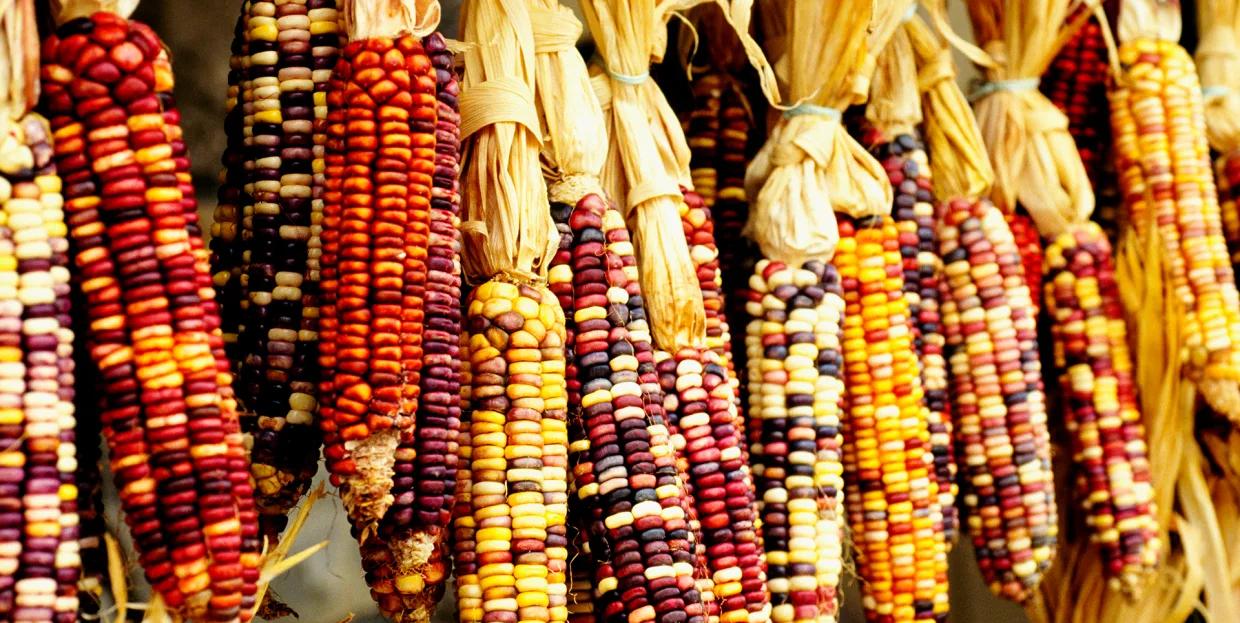What people ate in the American colonies depended largely on where they lived. Because of differences in climate, available natural resources, and the colonist's own cultural heritage, the Daily Diet of a New Englander was very different from his counterparts in the Central Colonies—New York, Pennsylvania, New Jersey, and Delaware—especially those in the South.
In the 13 colonies, in addition to imported goods such as spices, molasses and rum, people in the pre-Revolutionary War era mainly consumed their own food. They sow corn, fish, hunt game, raise farm animals for meat, and milk to make their own butter and cheese. They grow vegetables on their own gardens, brew their own beer, and squeeze their own cider.
While regional, seasonal, and other differences make it difficult to generalize a typical colonial diet, the following few foods and beverages are just a small sample that may be found on many colonial tables.
<h1 class="pgc-h-arrow-right" data-track="5" > Indian corn</h1>

A bouquet of flint corn.
Flint corn (also known as Indian corn) has a multi-colored white, blue, red and brown hue and is one of the oldest corn varieties. It was a staple food for Native Americans, who fundamentally saved the earliest colonists from starvation by teaching them how to grow crops, when to harvest them, and how to grind them into flour. Corn became a staple food in all 13 colonies, and corn flour was used in popular recipes such as fast-food pudding (milk-boiled corn) and Johnny cake, a fortified and highly portable food similar to pancakes.
<h1 class="pgc-h-arrow-right" data-track="7" > Birds of the Americas</h1>
The colonial forest was full of game, and turkey, venison, rabbit and duck were staples of the colonists' heavy meat diet. In addition to these well-known (by modern standards) options, many colonists also liked to eat passenger pigeons. During colonial times, birds were surprisingly numerous, and their meat was cooked in a variety of ways — including boiling, roasting, and baking into pies — similar to the way we use chicken today. In fact, the passenger pigeon was such a popular dish that the birds eventually went extinct. The last known passenger pigeon died in 1914.
A passenger pigeon drawn in 1896, it became extinct due to hunting.
Like many colonial dishes, pigeon cake originated in England, and Eliza Smith's The Compleat Housewife: or Accomplished Gentlewoman's Companion contained a recipe, a cookbook originally published in London and the first to be published in the colony in 1742. Smith's book reflects the major influences of British cuisine on colonial cuisine. Compleat Housewife is likely to have appeared in wealthy families in the late colonial era, when a midday "dinner" might have consisted of three courses, each with multiple dishes.
<h1 class="pgc-h-arrow-right" data-track="11" > potted meat</h1>
In the era long before refrigeration, popular food preservation methods included drying, salting, smoking, and salting, or a combination of these methods. Another method used to preserve meat is potted plants. This involves boiling the meat and packing it tightly into a jar, then covering it with butter, lard or butter (beef fat) before closing the lid. Potted plants keep meat safe for weeks or even months; then chefs will open the pot and cut the pieces as a meal.
<h1 class="pgc-h-arrow-right" data-track="13" > kimchi</h1>
Another common way to preserve food is pickling, an ancient method used by colonists for everything from meat and fish to fruits and vegetables. A plate of pickles was the most popular side dish on colonial tables, while beef was usually marinated with vinegar and salt water and kept in large wooden barrels. Colonial salt water may have been flavored with salt, saltpeter, and spices, but they didn't contain garlic, nahon says, and garlic wasn't considered purely medicinal until the 19th century.
<h1 class="pgc-h-arrow-right" data-track="15" > a variety of cookies</h1>
Jumble cookies — sometimes spelled "jumbal" — can be considered the ancestor of modern sugar cookies, albeit much sweeter. Recipes appeared in English recipes as early as 1585, and biscuits became a popular staple in the colonies. "You'll find thousands of mixed cookie recipes," Nahon said; even Martha Washington is said to have her own. Recipes in The Compleat Housewife require egg whites, flour, sugar and coriander seeds mashed into a paste, and Nahon says colonial chefs often season their mixed biscuits with rose water, a Middle Eastern import that reflects the vibrant trade and open cultural beginnings established by Dutch settlers in the Middle Eastern colonies. "There's a wide variety of cuisines here," Nahon says. "When you say colonial times, everyone thinks everything is gray, but that's not the case. We have a lot of wealth here. ”
<h1 class="pgc-h-arrow-right" data-track="17" > peppercake</h1>
The antibacterial properties of black pepper make it a good preservative, and this imported spice occupies a central place in pepperloaf, a gingerbread-like bread flavored with black pepper and molasses and garnished with candied fruit. For "Pepperloaf A Year You Will Keep Halfe" the classic colonial-era recipe was included in the Cookbook, which was given to Martha Washington in 1749 on the occasion of her marriage, and her first husband, Daniel Castis, wrote a manuscript.
<h1 class="pgc-h-arrow-right" data-track="19">Syllabub</h1>
Syllabub is a traditional British dessert made from whipped cream and alcohol.
Colonial Americans drank a lot of wine, a popular drink dessert dating back to the 18th century, mixing sweetened whipped cream with wine or cider. The resulting foam mixture is often supplied on special occasions. Amelia Simmons' American Cooking, which became the first cookbook published by Americans in the United States in 1796, included a recipe by Syllabub that required chefs to flavor cider with sugar, grind nutmeg, and then milk cows directly into the wine.